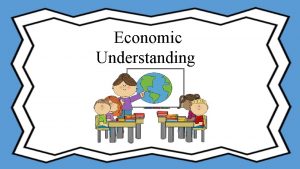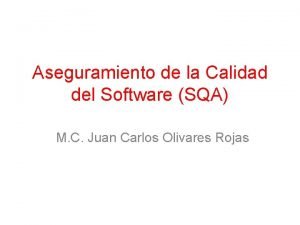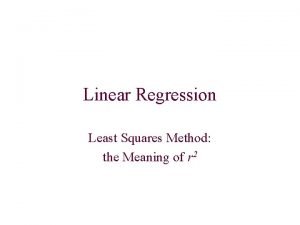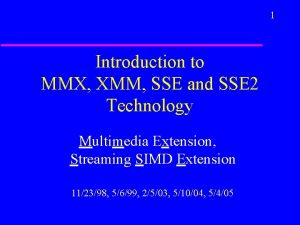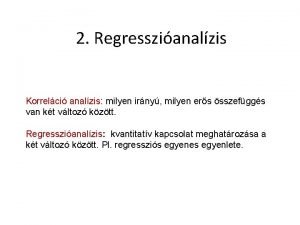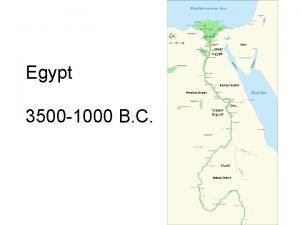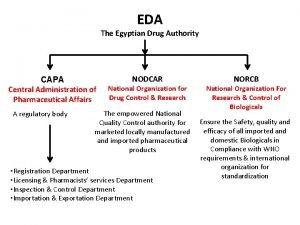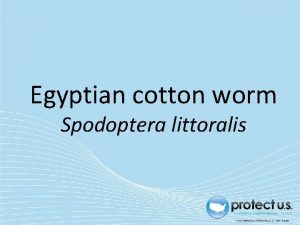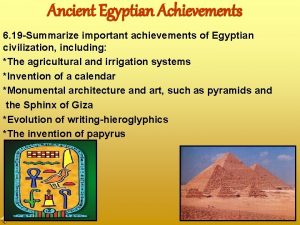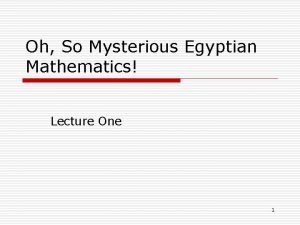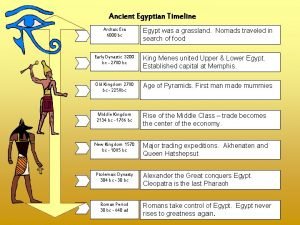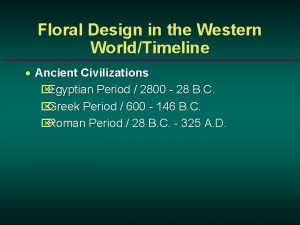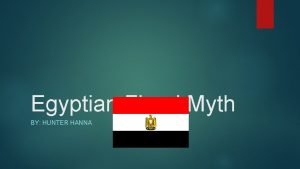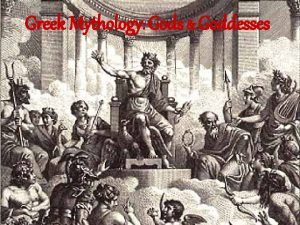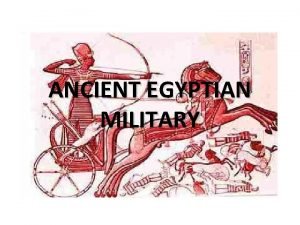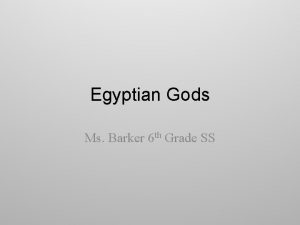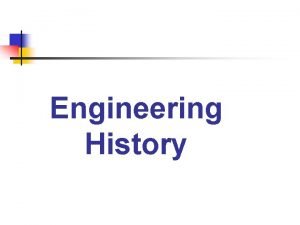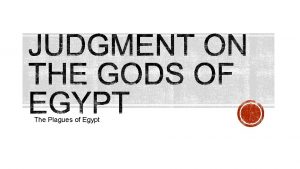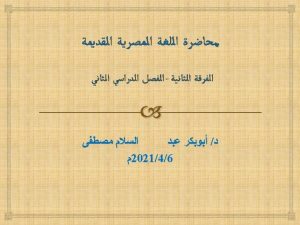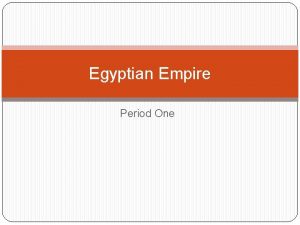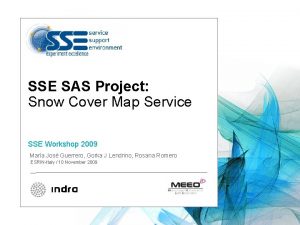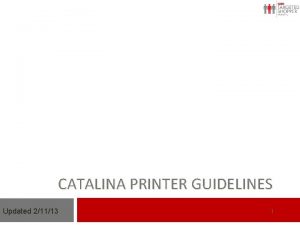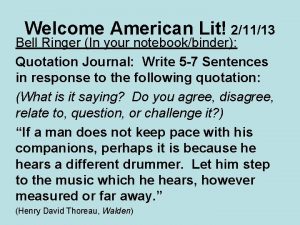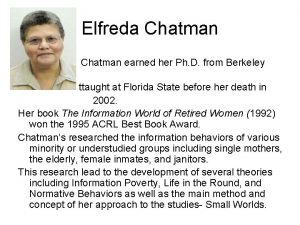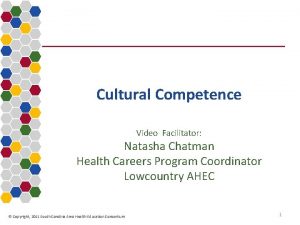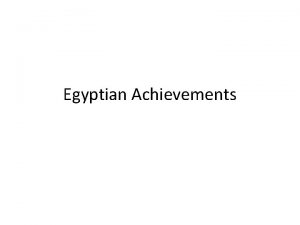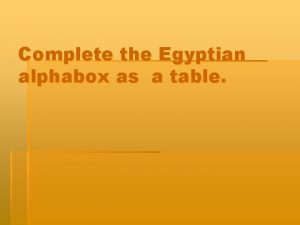Egyptian Geography Economics Carol Chatman SSE 6730 21113
















































- Slides: 48

Egyptian Geography & Economics Carol Chatman SSE 6730 2/11/13

The Nile River • River civilizations in the ancient world. http: //www. youtube. com/watch? v=dm 8945 K 4 d. H 0

The Nile River Facts • The Nile River is the primary river in Egypt and the longest river in the world (4184 miles). • While the Nile River is often associated with Egypt, it actually touches Ethiopia, Zaire, Kenya, Uganda, Tanzania, Rwanda, Burundi and Sudan, and flows past Cairo, Khartoum, Gondokoro, Aswan, Karnak, Thebes and the town of Alexandria. • Hapi is the male deity with strong female characteristics represented the fertility and vitality of the Nile River. • The major god most closely connected with the Nile was Osiris.

The Nile River Facts • The word 'Nile' is not ancient Egyptian. it comes from the Greek “neilos”, which means valley. The Nile flooded every year between June and September , in a season the Egyptians called akhet – the inundation. • The Nile flows into the Mediterranean Sea. • The largest source of the Nile is Lake Victoria. • The Ancient Egyptians called the river Ar or Aur (black) because of the color of the sediment left after the river’s annual flood.

The Nile River Farming • The Nile is fed by two main river systems. • In each August the climate of Egypt is at its hottest and driest. After two months the water recede leaving a dark grey muddy deposit of fertile soil on the land. When this happens the soil is perfect for farming and needs little help from irrigation. • There is no threat of the soil becoming unfertile because each year the soil is ‘miraculously” renewed by the flood. • Between 5000 and 4000 BCE permanent settlements of full time farmers became established in the valley of the Nile. • http: //www. youtube. com/watch? v=o. E 2 YZZg. ZWd. E

The Nile River Government • By 35000 BCE those north of the first cataract had merged into two kingdoms of Upper and Lower Egypt, in doing so founded what was to become the first “Dynasty” Of Ancient Egypt. • The rulers of the early farming communities are thought to have been religious leaders, “rainmakers” and controllers of the “flood”. • The majority of the population of Egyptians was made up of peasant farmers, who were taxed according to the annual level of the Nile at the height of its flood. • Around 2200 BCE the Old Kingdom was brought to an end when the Sahara rapidly dried out.

The Nile River Trade • The main exports of Ancient Egypt were grain from the Nile valley and gold from the Nubian mountains. • Ebony, Ivory, and Ostrich feathers were imported from the Nubian interior to the south. • Timber was an important raw material, it was imported from Byblos in Palestine. • Also imported were luxury imports from western Asia including spices, incense, and precious stones.

Gold Ostrich Feathers Ivory Ebony

The Nile River Osiris and Seth • Osiris and Seth http: //www. youtube. com/watch? v=1 d 1 It 74 k. OG 0 • Fertility of the Nile http: //www. youtube. com/watch? v=o. E 2 YZZ g. ZWd. E

Daily Life in Egypt’s Social Classes Rob Barrett SSE 6730 2/11/13

Introduction • A. Social Class - a group of people in society who have the same economic, cultural, and political status • B. Social Pyramid: describes the system of social class where high status classes have fewer members than low status classes

Ancient Egypt’s Social Pyramid • A. Government Officials – carried out Pharaoh’s powerful and wealthy • wishes, B. Priests – controlled temples and religious rituals • C. Scribes – respected because they could write and were important for government and business • D. Artisans – highly skilled craftspeople and artists • E. Peasants – largest class (but lowest status); worked the land helped on pharaohs’ projects


Life in Egypt’s social classes • • A. Fairly rigid (unchanging)—most people stayed in the class they were born in B. Common things between classes: 1. Family life was important 2. Men were head of household, women managed the home and raised children 3. Women had more freedom and rights than most women elsewhere at the time A. Could own land, run businesses, represent themselves in legal matters, work as government officials or priestesses 4. Quality of life was better higher on the pyramid 5. Egyptians believed this system created a stable society


Government Officials • A. Highest social class (after the pharaoh) • B. Assisted the pharaoh in ruling the country • C. Important officials: • 1. Vizier – high-ranking official, advisor to pharaoh • A. Appointed other officials • B. Was the head judge of Egypt • 2. Chief treasurer – controlled taxes and maintained wealth of the empire • 3. General of the Armies – top military commander (after the pharaoh) • 1. Lives of Luxury • A. Government officials had plenty of money and free time • B. Often held fancy banquets with many guests and fine food


Priests 1. Second highest class, very powerful and well respected • 2. Different jobs for Priests • A. High Priest – advised the pharaoh, ran religious ceremonies • B. Temple priests – took care of the god that lived in the statue within each temple’s sanctuary • C. Other priests - gave advice, handled healing etc. • 3. Priests’ Role in Burial Practices • A. Oversaw embalming (preparation for the afterlife)


Scribes • A. Third highest class, respected and well paid • B. Official writers and record keepers of Egypt • C. Men from any social class could become scribes (rare in the rigid class system) • 1. Scribe schools • A. Started around age 5 • B. Lasted 12 years • C. Students had to memorize over 700 Hieroglyphs (symbols representing words and sounds)


The Work of Scribes • • A. Recorded grain and food supply B. Wrote the census – official count of the population C. Many other jobs (recording taxes, legal rulings, military matters) 3. Tools: A. Finely sharpened reeds as pens B. Papyrus to write on C. Writing tablet to support papyrus (made of wood or stone)



Artisans • A. Craftspeople and artists • B. Closest to what we would call the “Middle Class” • C. Highly skilled, yet not well respected (often taken for granted) • D. Many specializations (carpentry, jewelry, painting, sculpting etc) • E. Stone carvers were very highly skilled and worked hard to make sculptures for wealthy Egyptians

Daily Life of Artisans • A. Lived in modest homes with about three rooms • B. Worked side by side in large workshops • C. Sometimes worked with hundreds of others on big projects • D. Usually didn’t receive recognition for their work


Peasants • • • A. Lowest class and by far the largest B. Produced the stable food supply that made Egyptian civilization possible 2. Three seasons of the Nile: A. Flooding season – June to September 1. Farmers worked on other projects (like pyramids) B. Planting season – October to March C. Harvest season – March – May 1. Busiest time of the year 2. People often worked from dawn to dusk

Daily life of peasants • A. Simple houses, little furniture • B. Food was simple, rarely included meat (in times of famine, sometimes they only had papyrus to eat) • C. Worked most of the time but had games for fun and celebrated several important holidays

Egyptian Politics Heather Manning SSE 6730 2/11/13

Political Structure • Theocracy – A system of government in which priests rule in the name of God or a god • Pharaoh was the Head of State, the highest priest and worshipped as Gods. • At a local level it was bureaucratic and regulated by officials. • “invented the concept of the nation-state that still dominates our planet, ”

Pharaohs • The original meaning of the word Pharaoh was “Great House” • The title of Pharaoh was passed from Father to son. • As a sign of authority the Pharaohs wore a false beard, a lions main and a head cloth with a cobra. • Although the power of the Pharaoh was absolute they were required to govern with peace and harmony and to perform certain duties.

Pharaoh’s Responsibilities • • Command the Army Head the War Council Head of administration for the Kingdom Served as Treasurer Ensured the harvest Preside over important religious rituals Enforce the bond between people and the gods.

Bureaucratic Structure • Viziers – “Superintendent of all works of the pharaoh” • Chief Priest of Amun • Overseer of the treasury • High Priests • Council of War • Overseer of Granaries • Priests • Others

Taxation • A strict tax was imposed on all citizens • They kept meticulous records of who owed what. • Taxes were often paid in the form of a portion of a farmers crops, meat or leather from animals or other food goods such as bread or beer. • The taxes (collected goods) were used to pay state employees, sold to finance state building projects or stored for later use. • Punishments for not paying taxes or underpaying were quick and severe.

Judicial System • Although no proof of them exists today, writings of an ancient Greek describe up to 8 books in which Egyptian laws were outlined. • Other documents however, such as the oldest known will, funeral documents, tax records, and court records all give us some insight.

Ma’at • Was an idea of truth, justice, peace, balance, harmony and order that dictated much of Egyptian life, including the justice system. • Under this idea everyone, except slaves, were equals under the law. • It was also personified as a goddess. • It was thought to be the norm for both society and nature.

Trials and Court • No lawyers existed in Ancient Egypt. • Trials were usually held in the courtyard of a temple and simply consisted of a statement by the plaintiff and a reply by the defendant. • The Judge varied but was often a local government official or priest and in rare cases the Pharaoh himself.

Punishements • A common torture/punishment was the beating of the soles of the feet. • Some more severe punishments carried over into the after life. The names and likeness of those punished were removed from their tombs and from records. • Many punishments affected not only the guilty but their entire family. – A man exiled or imprisoned may have to take his children (even if they were grown and innocent) with him.

Military • Ancient Egypt was not a heavily militarized society. • Perhaps at least in part because they did not need to be due to their protection from their geographic location and the displays of brutality when they did battle. • The military was also out of date in their weapons, continuing to use clubs and flint spears while other civilizations had started using metals such as bronze.

Egyptian Contributions Megan Thrasher SSE 6730 2/11/13

Pyramids • • • Abu Rawash Giza Zawyet el-Aryan Abu Sir Saqqara

Medicine • Best Physicians – Surgeries • Mumification – Removed organs and brain • Dentistry – Replacement teeth and removal

Hieroglyphics • Language – Logographic – Alphabet elements • Images – Represent real or illusional elements

Calendar • Year – 365 days long • Months – 12 months • Days – 30 days, plus five extra days(end of year)

Math • Developed and used in Ancient Egypt from ca. 3000 BC to ca. 300 BC • Math in Ancient Egypt was used for measuring the level of floods on the Nile River, measuring time, straight lines and calculating areas of land to name a few. • Unit fractions – Fractions were all written as unit fractions of the form 1/n

Other Notable Contributions • • • Paper (known as papyrus) Pen Makeup Waterclock Toothbrush and toothpaste

Video Clip • Egyptian Highlights
 Baroque period floral design
Baroque period floral design Opportunity cost example
Opportunity cost example Prof.sse
Prof.sse Nersc job script generator
Nersc job script generator Sse
Sse Sse can never be
Sse can never be Steven smolders
Steven smolders Sse-cmm
Sse-cmm Simd
Simd Sse keypad
Sse keypad Sse-cmm
Sse-cmm Sse linear regression
Sse linear regression Mmxxmm
Mmxxmm Determinációs együttható
Determinációs együttható Introduction to xamarin
Introduction to xamarin Non mathematical economics
Non mathematical economics School of business and economics maastricht
School of business and economics maastricht Studying geography economics and citizenship
Studying geography economics and citizenship Ap human geography political geography test
Ap human geography political geography test How to write an frq for ap human geography
How to write an frq for ap human geography 5 themes of geography ap human geography
5 themes of geography ap human geography 3500+1000
3500+1000 Egyptian throwing stick
Egyptian throwing stick How long egyptian civilization lasted
How long egyptian civilization lasted Amreya petroleum refining company
Amreya petroleum refining company Egyptian god weapons
Egyptian god weapons Atum egyptian god
Atum egyptian god Egypt cloth
Egypt cloth Eda capa
Eda capa Egyptian cotton worm
Egyptian cotton worm Early american period floral design
Early american period floral design Egyptian irrigation systems
Egyptian irrigation systems Egyptian numbers
Egyptian numbers Ancient roman toothbrush
Ancient roman toothbrush Egyptian gods
Egyptian gods 6000 bce egypt
6000 bce egypt Floral history timeline
Floral history timeline Egyptian flood story
Egyptian flood story Baghdad battery
Baghdad battery A traditional story about gods and heroes
A traditional story about gods and heroes Kamose
Kamose Egyptian sculpture
Egyptian sculpture Egyptian god of storms
Egyptian god of storms Egyptian easter traditions
Egyptian easter traditions Devilfish in egyptian waters
Devilfish in egyptian waters Egyptian irrigation systems
Egyptian irrigation systems Where did the pharaoh live
Where did the pharaoh live 10 plagues and egyptian gods
10 plagues and egyptian gods Easy egyptian drawings
Easy egyptian drawings

